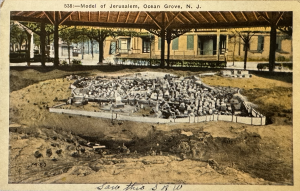 During high school, Aaron, a close friend, spent a summer in Israel and returned uplifted and rejuvenated. This isn’t surprising. Israel experiences serve as important catalysts for personal and Judaic growth.
During high school, Aaron, a close friend, spent a summer in Israel and returned uplifted and rejuvenated. This isn’t surprising. Israel experiences serve as important catalysts for personal and Judaic growth.
What moved Aaron, however, was not the hikes or the sites; rather, it was one, run-down, old synagogue.
Upon his return, Aaron wrote a vivid description of his experience at the Yakar Synagogue, the small shul in Old Katamon. I remember reading the article and picturing myself in the synagogue. Not usually a spiritual or religious person, Aaron described a room bursting with young congregants. He wrote of melodies that drifted out the open windows, winding down the streets of Jerusalem. As a lull came to the service, the singing let way to humming and thumping that reverberated from the second minyan – held on the floor above.
What I remember most vividly of Aaron’s description was not the spirituality of the service, but the simplicity of the space. Yakar is housed in an unassuming building at the corner of two quiet streets. The sanctuary had four plain white walls with cracks running along the ceiling. The few furnishings were stacking chairs and a wooden bimah.
Since Aaron visited Yakar, I have prayed there many times. The passion and vibrancy remains the same, though some of the cracks in the ceiling have been fixed. During a recent visit, I stayed with friends whose apartment backs onto the synagogue. Sure enough, on Friday evening, the calming melody of Yedid Nefesh flowed through their window gently reminding us that we were running late. As we rushed into the packed synagogue (we were far too late to get seats), I began to think about my synagogue experiences at home.
Toronto is experiencing a dearth of dynamic prayer communities. With few exceptions, our synagogues – spanning the denominational divide – are big-box establishments catering to a demographic far older than my own. Indeed, on a typical Shabbat, while listening obediently to a cantor chant the Amidah or a president make announcements that bear little relevance to me, I am left thinking, “Where is my synagogue?”
This, of course, is not a new phenomenon. In the 1820s, the young congregants of New York’s Shearith Israel petitioned the board to establish a service with fewer formalities, earlier worship times and a less hierarchical structure to worship. The proposal was quickly quashed by the trustees and so, in an act of rebellion, New York’s newest synagogue, B’nai Jeshurun, was founded.
Today, nearly 200 years later, BJ is one of the hot spots of the Jewish scene in New York, attracting nearly 500 young adults each Shabbat. The BJ model is being studied by other synagogues to determine how its innovations can be replicated.
Services at BJ and Yakar could not be more different. BJ (www.bj.org), a left-leaning Conservative synagogue, features professional musicians leading services with instruments amplified through a high-tech sound system. Yakar, (www.yakar.org/eng), on the other hand, is an Orthodox synagogue that calls itself a “Center for Tradition and Creativity,” and focuses on a “Judaism that is spiritual, welcoming and connected to the real world.”
What unites the two, however, is a sense of community. Both synagogues seek to break down barriers, engage individuals and challenge congregants to grow within the family of the shul. If our shuls in Toronto are the big-box Wal-Marts of synagogues, these are the “mom and pop” shuls where you get both a spiritual boost and a sense of community.
From each we can learn a lesson. Yakar demonstrates that a prayer space doesn’t need to be ornate. Often basements and dining rooms form the basis for growing communities, bridging the best of two primal Jewish institutions – the synagogue and the home. Similarly, BJ’s history exemplifies the richness of creativity and the depth of innovation.
We can’t wait for someone else to create a spiritual life for us. Rather, we must take the initiative and create our own spaces, our own shuls and our own communities.






